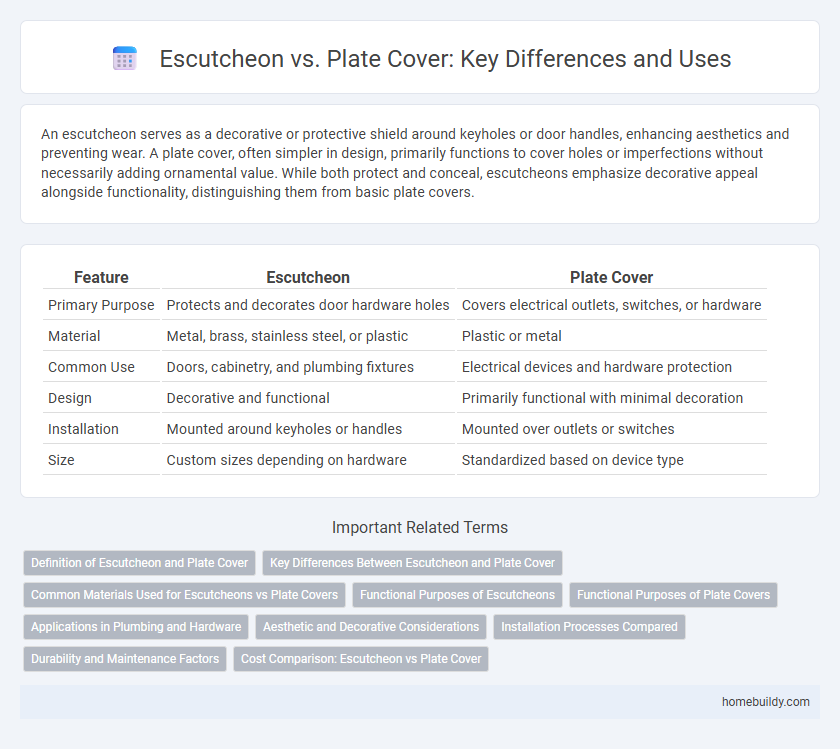An escutcheon serves as a decorative or protective shield around keyholes or door handles, enhancing aesthetics and preventing wear. A plate cover, often simpler in design, primarily functions to cover holes or imperfections without necessarily adding ornamental value. While both protect and conceal, escutcheons emphasize decorative appeal alongside functionality, distinguishing them from basic plate covers.
Table of Comparison
| Feature | Escutcheon | Plate Cover |
|---|---|---|
| Primary Purpose | Protects and decorates door hardware holes | Covers electrical outlets, switches, or hardware |
| Material | Metal, brass, stainless steel, or plastic | Plastic or metal |
| Common Use | Doors, cabinetry, and plumbing fixtures | Electrical devices and hardware protection |
| Design | Decorative and functional | Primarily functional with minimal decoration |
| Installation | Mounted around keyholes or handles | Mounted over outlets or switches |
| Size | Custom sizes depending on hardware | Standardized based on device type |
Definition of Escutcheon and Plate Cover
An escutcheon is a decorative or protective plate that surrounds a keyhole, lock cylinder, or door handle, often used to enhance aesthetics and protect surfaces from wear. A plate cover, while similar in function, typically refers to a broader category of covering plates that may include switch plates, outlet covers, or other protective hardware not specifically designed for locks or keyholes. Escutcheons are specialized components focused on door hardware, whereas plate covers serve more general protective or decorative roles in various settings.
Key Differences Between Escutcheon and Plate Cover
An escutcheon is a decorative or protective plate surrounding a keyhole or door handle, primarily designed to enhance aesthetics and provide protection against wear. In contrast, a plate cover mainly focuses on concealing and protecting door hardware or electrical components, often lacking ornamental features. Key differences include escutcheons typically having intricate designs for visual appeal, whereas plate covers prioritize functionality and clean coverage.
Common Materials Used for Escutcheons vs Plate Covers
Escutcheons are typically crafted from robust materials such as brass, stainless steel, and zinc alloy, offering durability and corrosion resistance ideal for both interior and exterior applications. Plate covers, often made from lighter materials like plastic or thin aluminum, prioritize ease of installation and cost-effectiveness but may lack the longevity of metal escutcheons. The choice between brass or stainless steel escutcheons versus plastic or aluminum plate covers impacts both aesthetic appeal and functional performance in protecting keyholes or plumbing fixtures.
Functional Purposes of Escutcheons
Escutcheons serve as protective and decorative covers that conceal keyholes, pipe penetrations, or lock mechanisms, preventing dust, dirt, and moisture from entering openings. Unlike standard plate covers, escutcheons often feature intricate designs that enhance aesthetic appeal while providing a snug fit for enhanced security and durability. Their functional purpose extends to safeguarding underlying fixtures and ensuring seamless integration with architectural elements.
Functional Purposes of Plate Covers
Escutcheons primarily serve as decorative elements surrounding door handles or keyholes, enhancing aesthetic appeal and concealing mounting hardware. Plate covers, however, focus on functional purposes such as protecting door surfaces from scratches, wear, and damage caused by frequent use and key insertion. Unlike escutcheons, plate covers are designed to reinforce the area around locks, improving durability and extending the lifespan of doors.
Applications in Plumbing and Hardware
Escutcheons in plumbing serve as decorative and protective covers for pipe penetrations, sealing gaps between pipes and walls or floors to prevent water damage and improve aesthetics. Unlike plate covers, which are typically flat and used for electrical outlets or switches, escutcheons are often shaped to accommodate the contour of plumbing fixtures, providing a snug fit around pipes and valves. In hardware applications, escutcheons protect keyholes or lock cylinders from dust and tampering, whereas plate covers primarily serve as mounting or decorative elements for switches and outlets.
Aesthetic and Decorative Considerations
Escutcheons provide a refined and elegant aesthetic by offering intricate designs and smooth finishes that enhance door hardware visually, while plate covers often have a more utilitarian appearance with simpler forms. The decorative potential of escutcheons allows customization to complement interior styles, whether traditional, modern, or vintage, making them a favored choice for enhancing door detail. In contrast, plate covers prioritize protective function over ornamentation, resulting in less emphasis on aesthetic appeal.
Installation Processes Compared
Escutcheons typically require precise alignment and secure fastening to cover and protect keyholes or plumbing fixtures, often involving screws or adhesive mounts for stability. Plate covers generally offer a simpler installation, snapping into place over switches or outlets without extensive hardware, making them more user-friendly for quick upgrades or repairs. Both components must be measured accurately to ensure a proper fit, but escutcheons demand more attention to detail due to their decorative and protective roles.
Durability and Maintenance Factors
Escutcheons typically offer superior durability compared to plate covers due to their solid metal construction and corrosion-resistant finishes, making them ideal for high-traffic or outdoor applications. Maintenance of escutcheons is minimal, often requiring only occasional cleaning to prevent tarnish or buildup, whereas plate covers may degrade faster and need more frequent replacement or touch-ups. Their robust design helps escutcheons maintain functionality and aesthetic appeal longer under harsh environmental conditions.
Cost Comparison: Escutcheon vs Plate Cover
Escutcheons typically cost more than plate covers due to their intricate designs and durable materials such as brass or stainless steel. Plate covers are often made from thinner, less expensive materials like plastic or lightweight metals, making them a budget-friendly option. When balancing aesthetics and expense, escutcheons offer a higher-end, long-lasting solution, while plate covers provide a cost-effective alternative for basic protection and coverage.
escutcheon vs plate cover Infographic

 homebuildy.com
homebuildy.com